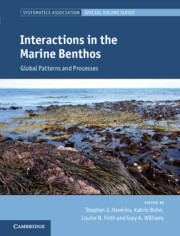Book contents
- Interactions in the Marine Benthos
- The Systematics Association Special Volume Series
- Interactions in the Marine Benthos
- Copyright page
- Contents
- Preface
- Contributors
- Chapter 1 Introduction
- Chapter 2 The Intertidal Zone of the North-East Atlantic Region
- Chapter 3 The Ecology of Rocky Subtidal Habitats of the North-East Atlantic
- Chapter 4 Rocky Intertidal Shores of the North-West Atlantic Ocean
- Chapter 5 Subtidal Rocky Shores of the North-West Atlantic Ocean
- Chapter 6 Shallow Water Muddy Sands of the North-West Atlantic Ocean
- Chapter 7 Biodiversity and Interactions on the Intertidal Rocky Shores of Argentina (South-West Atlantic)
- Chapter 8 Species Interactions and Regime Shifts in Intertidal and Subtidal Rocky Reefs of the Mediterranean Sea
- Chapter 9 The Restructuring of Levant Reefs by Aliens, Ocean Warming and Overfishing
- Chapter 10 North-East Pacific
- Chapter 11 The North-East Pacific
- Chapter 12 Consumer–Resource Interactions on an Environmental Mosaic
- Chapter 13 Where Three Oceans Meet
- Chapter 14 Rocky Shores of Mainland China, Taiwan and Hong Kong
- Chapter 15 Biogeographic Comparisons of Pattern and Process on Intertidal Rocky Reefs of New Zealand and South-Eastern Australia
- Chapter 16 The Past and Future Ecologies of Australasian Kelp Forests
- Chapter 17 Kropotkin’s Garden
- Chapter 18 Biofilms in Intertidal Habitats
- Chapter 19 Interactions in the Deep Sea
- Chapter 20 Overview and Synthesis
- Index
- Systematics Association Special Volumes
- References
Chapter 19 - Interactions in the Deep Sea
Published online by Cambridge University Press: 07 September 2019
- Interactions in the Marine Benthos
- The Systematics Association Special Volume Series
- Interactions in the Marine Benthos
- Copyright page
- Contents
- Preface
- Contributors
- Chapter 1 Introduction
- Chapter 2 The Intertidal Zone of the North-East Atlantic Region
- Chapter 3 The Ecology of Rocky Subtidal Habitats of the North-East Atlantic
- Chapter 4 Rocky Intertidal Shores of the North-West Atlantic Ocean
- Chapter 5 Subtidal Rocky Shores of the North-West Atlantic Ocean
- Chapter 6 Shallow Water Muddy Sands of the North-West Atlantic Ocean
- Chapter 7 Biodiversity and Interactions on the Intertidal Rocky Shores of Argentina (South-West Atlantic)
- Chapter 8 Species Interactions and Regime Shifts in Intertidal and Subtidal Rocky Reefs of the Mediterranean Sea
- Chapter 9 The Restructuring of Levant Reefs by Aliens, Ocean Warming and Overfishing
- Chapter 10 North-East Pacific
- Chapter 11 The North-East Pacific
- Chapter 12 Consumer–Resource Interactions on an Environmental Mosaic
- Chapter 13 Where Three Oceans Meet
- Chapter 14 Rocky Shores of Mainland China, Taiwan and Hong Kong
- Chapter 15 Biogeographic Comparisons of Pattern and Process on Intertidal Rocky Reefs of New Zealand and South-Eastern Australia
- Chapter 16 The Past and Future Ecologies of Australasian Kelp Forests
- Chapter 17 Kropotkin’s Garden
- Chapter 18 Biofilms in Intertidal Habitats
- Chapter 19 Interactions in the Deep Sea
- Chapter 20 Overview and Synthesis
- Index
- Systematics Association Special Volumes
- References
Summary
The ‘deep sea’ encompasses a broad range of habitats that differ greatly in their assemblages and ecosystem functioning. Habitats may be described by a combination of environmental factors (e.g., depth, slope) and biotic factors (e.g., source of primary productivity). We review recent attempts to define deep-sea biogeographic provinces based on spatial and temporal variations in oceanographic conditions, and consider potential boundaries to distributional ranges, in particular habitats based on recent phylogeographic studies. We briefly discuss abiotic interactions in various habitats, noting the particular influence of local hydrodynamics. We consider competition and predation at whale falls and hydrothermal vents, discuss symbiotic interactions particularly with respect to deep-sea corals, which are particularly prevalent in submarine canyons and seamounts, and consider the difficulties of inferring processes from patterns.
Keywords
- Type
- Chapter
- Information
- Interactions in the Marine BenthosGlobal Patterns and Processes, pp. 474 - 487Publisher: Cambridge University PressPrint publication year: 2019
References
- 1
- Cited by

